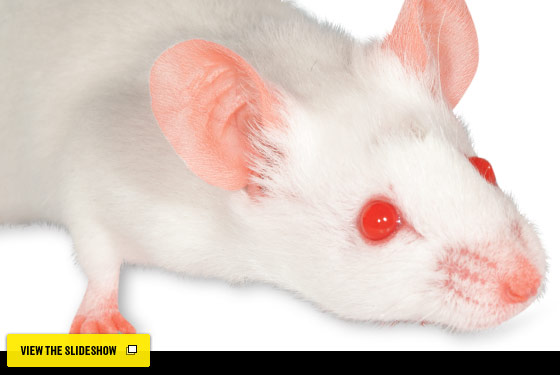
Photographs by Catherine Chalmers
One hundred thousand of the world’s most valuable rodents live on York Avenue as residents of Rockefeller University, whose relative obscurity among the city’s higher-learning establishments belies its elite status in the medical community. (Twenty-three Nobel laureates have done work at the school, which doesn’t offer undergrad degrees.) A few of its more cooperative mice—and one rat—recently took turns in front of our cameras.

This genetically modified, white-and-red creature is used in studies of a protein called keratin-14, which gives structure to skin cells but can cause cancer when found in excess. The mouse carries a fluorescent protein that lights up only in cells containing keratin-14. The dye helps researchers more easily find and extract those particular cells, which are in turn injected into other mice for study. Glow-in-the-dark mouse’s fluorescence helps ID key protein.

The Friedman lab also features a crew of fat rats like the one seen here. “I love working with rats,” says Olof Dallner, a staffer. “They are completely calm.” (The downside, for research purposes: Rats need more space and food.) A rat! Useful because it’s less skittish than its mousy peers.

The creation of a vaccine for hepatitis C has been stymied by science’s inability to study human liver cells outside of the body. This mouse, created by Rockefeller’s Charlie Rice and his team, could be turning point: its liver is almost entirely made of human cells. However, it lacks an immune system, the other essential component for vaccine research. The Rice lab is trying creating a mouse with both human liver and immune cells. Success could lead to breakthrough treatments not only for hepatitis C but also for yellow fever, malaria, and other infectious diseases. Mouse with human-like liver could help cure hepatitis.

This pumpkin-colored two-month-old has been given a gene that marks brain cells containing prodynor”phin, a chemical linked to sensations of pleasure and pain. The gene is like a neon arrow illuminating the neurological signals and pathways that induce eating. Pumpkin-colored mouse has an easily studied brain.

These mice, from Friedman’s lab, eat pellets that are 60 percent fat; they’re used in research into leptin’s influence on neurological processes. The lab has found links between eating and emotional centers in the brain, which could help explain why the human response to food can have little to do with its nutritiousness. Greasy-coated mice are fed high-fat diets.
